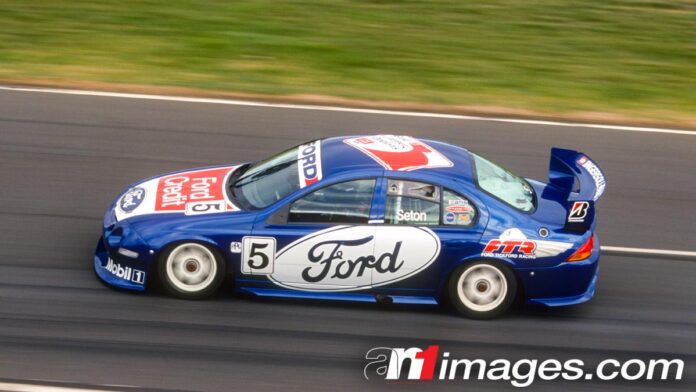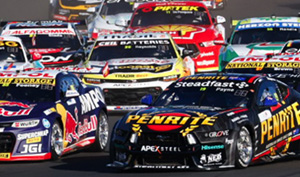WOULD you let a journalist loose in your V8 Supercar little over a week before the Bathurst 1000?
That’s exactly what Glenn Seton did in 1999, as this special feature story from the Motorsport News Archive shows.
Truth be told the chosen journo, MN founding publisher Chris Lambden, is no hack behind the wheel, with extensive touring car racing experience under his belt.
Lambden’s talent with both pedals and pen therefore made for a great insight into what it was like to drive a V8 race car like Seto’s 1999 Ford Tickford Racing Falcon AU.
Call it a leap of faith. Would you let anyone in your $250,000 factory Ford just over a week before Bathurst?
I’m pretty sure I wouldn’t, but guess what – Glenn Seton did just that this week so that we could remind you folk just what it’s like to juggle 600+ hp and just how good a car the very latest V8 Supercar really is.
The #5 car was at Calder on Monday, utilising a private session to bed in brand new driveline components and also put the finishing touches to testing and mapping the MoTeC engine management and data acquisition system, having switched to Richard Bendall’s product since the Queensland 500.
Engineer Ken Douglas was on hand to oversee the MoTeC work and it was between sessions of this task that we were able to jump into the car for an up-date on the V8 Supercar experience.
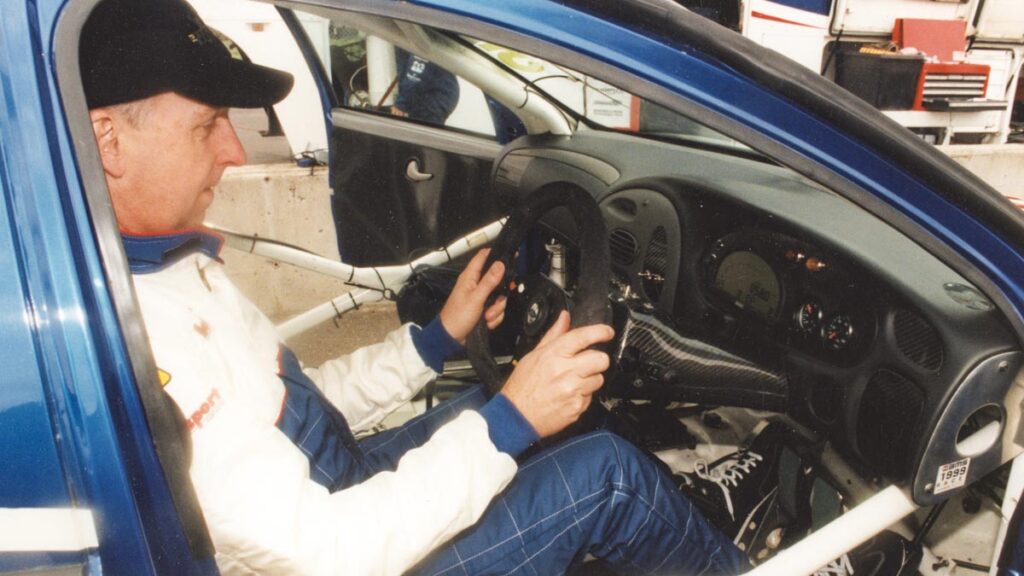
Since our last similar drive (in HRT’s ’96 SATCC/Sandown/ Bathurst-winning VS Commodore) not too much has changed in a physical sense apart from the newer body shapes, but things get refined.
First impression: a little thing, but Glenn’s latest Velo seat, modified to his spec, fits like a glove. The side support under your arms is noticeably more ‘wraparound’ – something I always figured was a big plus. After all, it’s hard to be as precise as these guys need to be if you’re flailing around in the seat, using the steering wheel to hold yourself in…
With the belts done up tightly, there’s no energy involved in holding yourself in situ – all that can be directed to the job in hand.
Optimistically, one of Glenn’s crew shows me how to engage the ‘lockout’ reverse gear (using a gnurled knob on top of the gearbox) “just in case…”. Thanks, buddy.
There is in fact a small array of dials and the ubiquitous MoTeC dash, but with all now able to be monitored from the pits in ‘real time’ telemetry, there’s little need to take a lot of notice.
As you’ve probably ascertained from the spectator banks, these things are as docile as a street car if you want them to be on the way out of pit lane, so we opt for a dignified pit lane exit, but then docility goes out the window…
The six-speed H-pattern Holinger is the crisp, positive gearbox it has always been and, with 600+ of Mr Ford’s best equines driving through Bridgestone’s control rubber, acceleration is exhilarating.
Even with a Bathurst diff ratio, the Falcon pulls strongly out onto Calder’s front straight in second. Third, fourth, fifth. Heading up over 230 kph, towards 250 over the slight crest in Calder’s front straight. This thing is rock solid.
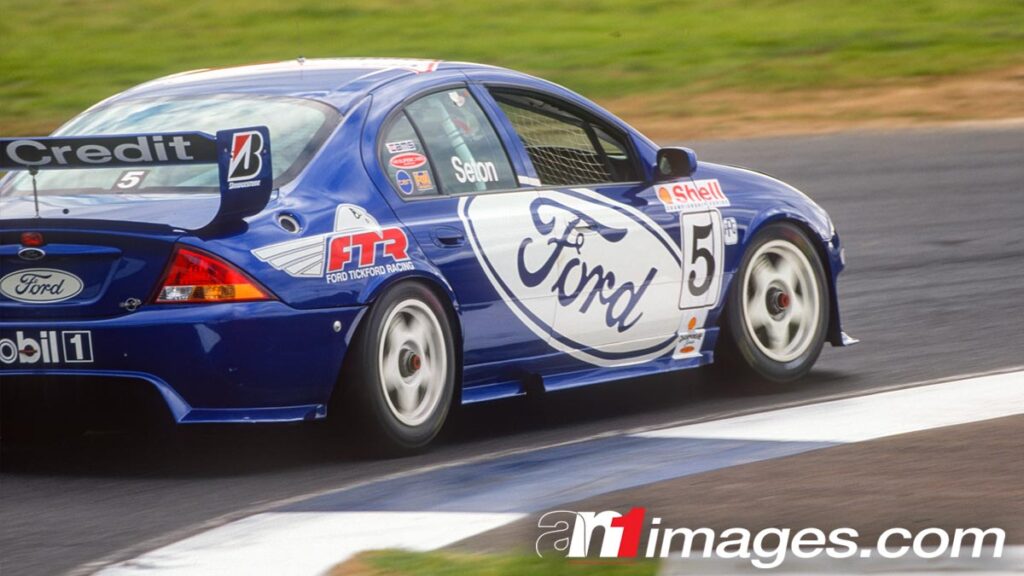
Once upon a time V8s used to jiggle just a bit, float a tad over these high-speed bumps, but not any more. You may as well be on the new Citylink Freeway – at 250 kays…
Onto the brakes a little earlier than Mr Seton would, and what a feel of confidence. Very firm pedal, very little dive, just full, straight, clean deceleration, the engine spiralling down off its peak hum, a couple of blips and second for Calder’s 180 degree turn one.
According to engineer Douglas, who calls up one of Seton’s laps on the computer, he brakes 58.8 metres before turn-in. Bloody engineers. Let’s call that 60 metres, shall we…
Regardless, that’s impressive, hauling 1350kgs down from 250 kph to a second gear loop.
Into turn one and around it, Calder has become quite bumpy, but that’s where the finesse of the modern spring/shock absorber set-up comes into its own.
Seton has always set his cars up slightly on the softer side and the latest AU is no different, but the steering response is nevertheless impressive and rapid.
Hardly a ripple is translated through to the steering wheel as we wheel through the turn and back onto the throttle for the brief, power-band spurt, to the right-left esses.
A trace of understeer into the right, but precise with it, rapid transition from right to left as we ease out over Calder’s ‘hill’.
Short change to third over the crest as things go light for a moment, then into fourth, through the kink, a brief touch of fifth before it’s back all the way to second again for the second esses and another ‘power squirt’ to the final corner.
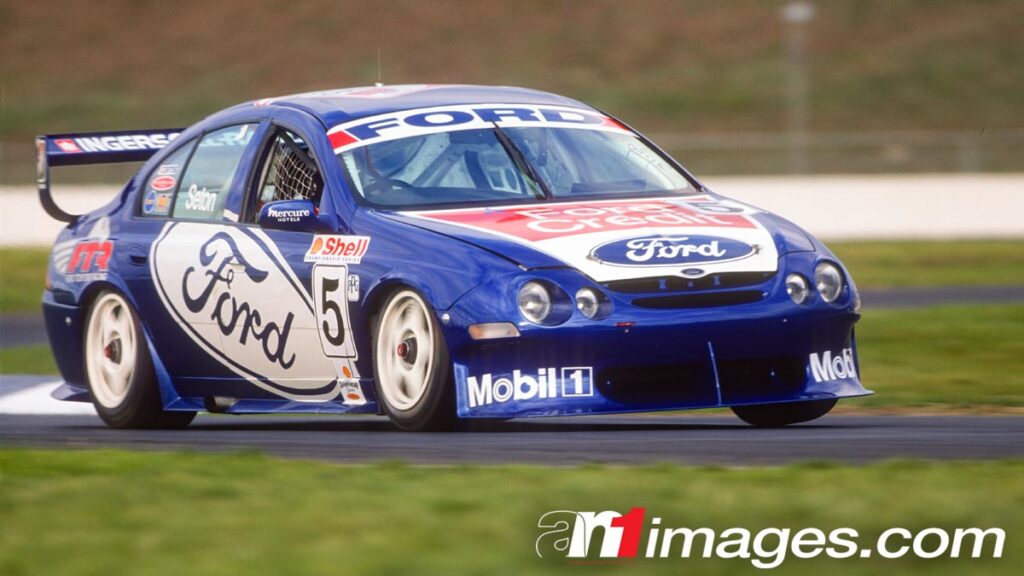
This too is right ‘in the band’ and you can sense the Bridgestones working at their peak in terms of drive, almost but not quite breaking traction, an almost elastic-band feel as the car is propelled forwards.
As smooth as possible out of the unwinding final turn, working the power down, then the simple exhilaration of pure, full throttle acceleration down Calder’s main straight, 7,500rpm of V8 roar, flashing past the group of moderately apprehensive FTR faces!
This is great. Nice. Nice? Hardly how one ought to describe a 600+ hp race car, but it’s almost true. At the seven, maybe eight-tenths, that this test is by necessity conducted at, the FTR Falcon is strong and muscly, but secure and predictable. Easy to become over-confident, I’d guess…
It’s when those couple of extra tenths are demanded – and that’s most of the time in today’s ultra competitive world of V8 Supercars – that any deficiency or glitch would become apparent.
For now, though, I can report that our V8 Supercar drivers have a terrific piece of touring car equipment at their disposal.
The almost universal use of power steering (no heavier than your road car in Seton’s case) steady advances in shock absorber technology and data acquisition, brakes to die for and the latest in Bridgestone grip form a package that must be a delight to push to its peak.
Physically, it’s not hard. The effort and sweat comes from the sheer concentration (and heat in longer races) and mental effort.
It’s a refined package and, thanks to the category’s constraints, a settled one. No wonder there is, so frequently, such little time between the top ten runners.
But getting the very maximum number of those 600+ horses through to the ground is the key. It must be the tiny tweaks that make the difference…


